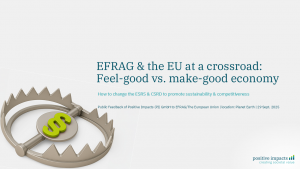EFRAG & the EU at a crossroad: �Feel-good vs. make-good economy?
How to change the ESRS & CSRD to promote sustainability & competitiveness
Public Feedback of Positive Impacts (PI) GmbH to EFRAG/The European Union

Europe’s sustainability reporting rules (ESRS/CSRD) are at risk of becoming a 𝗰𝗼𝗺𝗽𝗹𝗶𝗮𝗻𝗰𝗲 𝗲𝘅𝗲𝗿𝗰𝗶𝘀𝗲 — complex, costly, and symbolic — while non-EU competitors avoid these burdens. This “feel-good” path could undermine both 𝘀𝘂𝘀𝘁𝗮𝗶𝗻𝗮𝗯𝗶𝗹𝗶𝘁𝘆 and 𝗰𝗼𝗺𝗽𝗲𝘁𝗶𝘁𝗶𝘃𝗲𝗻𝗲𝘀𝘀.
In our feedback to EFRAG & the EU, we argue for:
✔️ 𝗖𝗹𝗲𝗮𝗿 𝗿𝗲𝘃𝗲𝗻𝘂𝗲-𝗯𝗮𝘀𝗲𝗱 𝗮𝗰𝗰𝗼𝘂𝗻𝘁𝗶𝗻𝗴 𝗿𝘂𝗹𝗲𝘀 — accountability where decisions are made
✔️ 𝗖𝗼𝗻𝘀𝗲𝗻𝘀𝘂𝗮𝗹, 𝘀𝘁𝗮𝗻𝗱𝗮𝗿𝗱𝗶𝘇𝗲𝗱 𝗘𝗦𝗚 𝗞𝗣𝗜𝘀 — comparability without clutter
✔️ 𝗠𝗮𝘁𝗲𝗿𝗶𝗮𝗹𝗶𝘁𝘆 𝗮𝗽𝗽𝗿𝗼𝗮𝗰𝗵𝗲𝘀 𝘁𝗵𝗮𝘁 𝗺𝗮𝗸𝗲 𝘀𝗲𝗻𝘀𝗲 — impact materiality pre-defined by society (“no” entity-level materiality), complemented by options that allow a strategic fit instead of one-size-fits-all
✔️ 𝗦𝗶𝗺𝗽𝗹𝗲 𝗿𝘂𝗹𝗲𝘀 — fostering innovation and growth, not box-ticking
👉 Read the full feedback here:

https://positive-impacts.com/wp-content/uploads/2025/09/PI-Feedback_to_EFRAG_and_the_EU.pdf
—
🔹 𝗠𝗲𝗮𝗻𝘄𝗵𝗶𝗹𝗲 𝗮𝘁 𝗣𝗜, 𝘄𝗲 𝗵𝗲𝗹𝗽 𝗼𝗿𝗴𝗮𝗻𝗶𝘇𝗮𝘁𝗶𝗼𝗻𝘀, 𝗶𝗻𝘃𝗲𝘀𝘁𝗼𝗿𝘀, 𝗮𝗻𝗱 𝗽𝗿𝗼𝗷𝗲𝗰𝘁𝘀 𝗽𝘂𝘁 𝘁𝗵𝗶𝘀 𝗶𝗻𝘁𝗼 𝗽𝗿𝗮𝗰𝘁𝗶𝗰𝗲:
- 𝗧𝗵𝗲 𝗣𝗜® 𝗜𝗺𝗽𝗮𝗰𝘁 𝗔𝗰𝗰𝗼𝘂𝗻𝘁𝗶𝗻𝗴 𝗙𝗿𝗮𝗺𝗲𝘄𝗼𝗿𝗸 → track positive & negative impacts without impact-washing
- 𝗧𝗵𝗲 𝗣𝗜® 𝗩𝗮𝗹𝘂𝗲 & 𝗥𝗶𝘀𝗸 𝗙𝗿𝗮𝗺𝗲𝘄𝗼𝗿𝗸 → link impacts to financial value, risk & opportunity
- 𝗧𝗵𝗲 𝗣𝗜® 𝗦𝘁𝗿𝗮𝘁𝗲𝗴𝘆 𝗙𝗿𝗮𝗺𝗲𝘄𝗼𝗿𝗸 → align ambition levels with business strategy
Previous PI comment about the European Sustainability Reporting Standards (ESRS) Draft of the European Financial Reporting Advisory Group (EFRAG)
We advice EFRAG to standardize sustainabilty performance and not its management!
- Define selected mandatory sustainability indicators, ideally on activity level, to be reported along the value chain based on their absolute impacts on society – irrespective of an entity’s materiality judgement, with clear thresholds like 50 g CO2e/1 € revenue. Entities should be furthermore required to report these in an aggregated way (cradle-to-gate scope). In addition, consider working towards monetization factors to quantify the related impacts on society in monetary terms. Such indicators can, however, be complemented with related optional KPIs to be used in integrated reporting that links financial and sustainability performance.
- Require the disclosure of the strategic intent and give the freedom to declare all other disclosure requirements (materiality, governance, strategy, risk, and opportunity management) as not applicable based on their imperative. This also means to delete the rebuttable mechanism.
- Prevent standard-driven “Only PR” approaches by making the materiality analysis voluntary based on the strategic intent with “single” or “double materiality” as optional definitions to ensure that it matches with the materiality philosophy of the management/strategy of the firm. If done according to the ESRS, materiality matrices should contain the main dimensions “impact on society” (y-axis) and “impact on business” (x-axis), and the sub-dimensions actual- vs. potential impact on business (z-axis). Methods of determination and cut-offs should not be standardized. Rename the dimensions accordingly as both terms and definitions (“impact materiality” and “financial materiality”) are misleading and incomplete (see our paper What’s material?!).
Reasoning: In essence, sustainability/ESG is about changing the way business is done and not about reporting; this should be the guiding principle for any sustainability standard. To date, strategies and management approaches are not standardized to ensure competition and provide organizations with a necessary level of freedom, including the decision of some organizations to comply only with legal regulations. Any standard that suggests an organization should be doing more risks producing standard-driven “Only-PR” approaches. Instead, it could be more efficient for governments to create incentives for the market to reach a sustainable development that maximizes Societal Value. A global standard that determines the principles and rules for accounting Societal Value KPIs would be a step forward for measuring and comparing an organization’s sustainability performance. Relatedly, the identification of material topics and KPIs should be coupled with the organization’s management strategy. The ESRS should define core metrics on activity level for sustainability performance and reporting, including the upstream value chain for selected indicators. This enhances transparency, as outsourcing a certain production step may be a feasible approach to fool the primary users of a report. You can find PI’s complete response here



